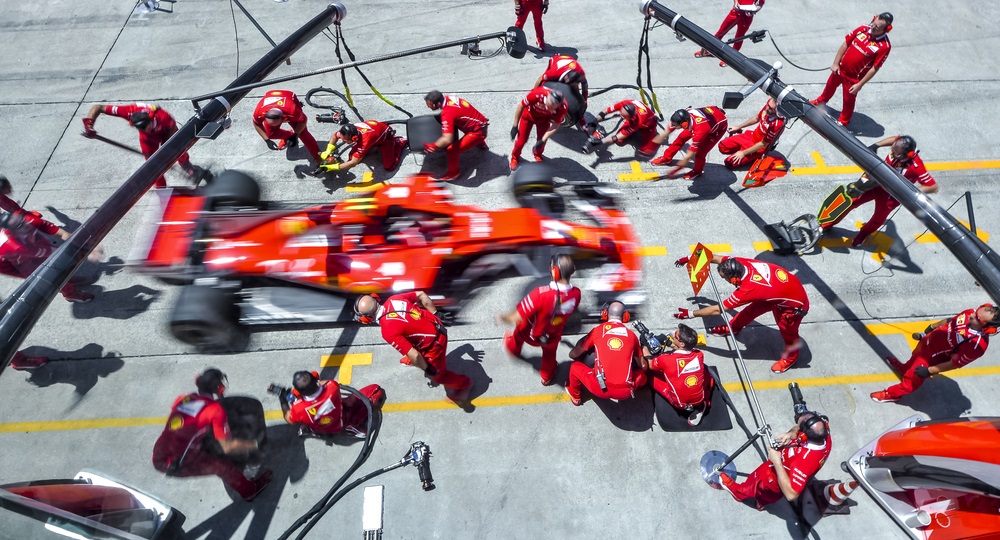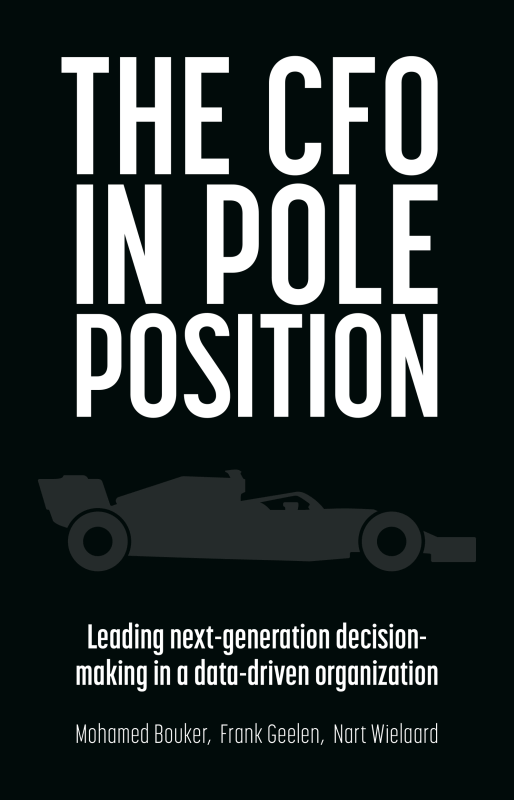
In the world of racing, drivers and team managers used to base their decisions on a combination of experience, expertise, and intuition. This is no longer the case. Today, they increasingly do so on the basis of hard data and advanced models: they have transformed into Decision Oriented Organizations. There are valuable lessons to be learned from this for the business community.
Winning a Formula 1 Grand Prix without the benefit of high-quality data analysis has become nearly inconceivable. To the fans, data strategy is all but invisible, but behind the scenes, competition is thwarted through effective interpretation of the data; data on engine performance, wear and tear of the tyres, cloud formation over the racetrack, and how these relate to the strategy for a particular race, to name but a few.
Whether, for example, an ’undercut’ (i.e. a cleverly timed early pit stop) is a sensible strategy is determined by mathematical models using live data rather than by a human being. As such, Formula 1 is playing in the proverbial Champions League of data analysis.
The devil is in the detail, especially when a fraction of a second can make the difference, as it does in motorsports. The Chief Information Officer at Red Bull Racing described how each season data analysis leads to as many as 30,000 large and small changes to the car to maximize its racing performance.
The important role of data collection was, for example, demonstrated in 2018, when the Formula 1 circus arrived in Austin, Texas. Heavy rains flooded the track and put an end to the Friday training sessions. The teams had barely been able to collect any data, and their racing strategies were more of a leap of faith than actual strategies. For example, none of the teams had had the opportunity to test their slicks – tyres for dry conditions. This unusual situation caused the Sunday race to enter the books as a magnificent and spectacular battle and with large differences between the strategies of the top teams. For the unbiased spectators, this was a real treat compared to many of the other races which are often rather predictable – much to the chagrin of many motorsport enthusiasts.
The genie is out of the bottle
For Ross Brawn, managing and technical director of Formula 1, the impact of the incident in Austin led him to ponder whether such a spectacle could not be realized more often by introducing a restriction on the use of data. He compared this with a football match: if two teams both play a technically perfect game, the result would be a 0-0 tie. But that is not what spectators come to see. The key question, according to him, is whether less data leads to a better show. According to him that is the real question since less predictability could make the sport more attractive for spectators going forward. When asked, Toto Wolff, team principal and CEO of the Mercedes AMG Petronas Motorsport Formula 1 Team – one of the top teams in Formula 1 – appeared to agree with Brawn’s reasoning. But he also added that, in such a case, the teams could be expected to find ways around the racetrack restrictions on data collection. His opinion suggests the sport’s data addiction is unstoppable – the genie is out of the bottle.
It is difficult to predict how this trend will develop, but imagining a scenario in which Formula 1 races are held without human drivers behind the wheel is not. Where algorithms compete against each other – and perhaps do better than people do. Although this could be the ultimate safety measure, it is very doubtful whether the sport will have any fans left once the human daredevil element is taken out of the equation.
And here ends this attempt at gazing into a crystal ball. What is certain is that the genie is out of the bottle where the use of data is concerned. And the same is happening within the business community. Just as Formula 1 teams compete at the cutting edge of World Championship racing through the clever use of data, so are businesses only able to stay ahead of their competitors by joining the front-runners in their particular field. Just as Formula 1 teams have transformed into Decision Oriented Organizations, enterprises should follow suit.
So much for gut feelings
In a world filled with data, our decisions all become much more explicit. In any number of professions – whether racing car drivers, team managers, entrepreneurs, or CEOs – decisions in the past would normally be made on the basis of experience, expertise, and intuition. In doing so, people felt certain that they were taking the right decisions. That is no longer common practice; these days, decisions rely increasingly on hard data.

This, of course, does not alter the fact that, at least for now in Formula 1, you still need a certain talent to win a race; drivers who understand the technology and know how to best take advantage of that technology. There is, however, one big difference with the racing world of decades ago: decisions by drivers and team managers these days are almost entirely data driven and, as such, are largely irrefutable. These decisions are also more explicit than ever before. And the racing rationale is compelling: data-driven decisions have been proven to make you faster.
Optimize your price strategy
Things are no different in the business world. As a marketeer, you may once have decided on pricing strategies or services instinctively, but today algorithms are used that feed on data and then predetermine which pricing strategy would lead to the best result. Even more so, an algorithm is able to endlessly vary the price per customer or per second, without any human intervention.
The same applies to shelf management in a supermarket: an algorithm is much more efficient than any human at determining (in real time) when stocks run low and what needs to be ordered from a central warehouse. The same line of reasoning is conceivable for almost any process. There are now businesses that no longer need human input to draw up their annual budgets. Algorithms are used for determining a business manager’s targets on the basis of various data sources.
This radically changes the profession of managers and directors. Their decisions become much more transparent; the way that data and algorithms were used in making certain decisions is very transparent or can be made transparent. Contrary to popular belief, an algorithm is not always a black box: its decisions can actually better be explained than those of the supposedly inimitable human brain. Businesses are greatly attracted to the promise of better decisions that come with the use of this data-driven technology – but this does not happen automatically.
Similarly to the Formula 1 driver and his team, in business you need to have a large amount of reliable data at your disposal.
Formula 1 teams collect relevant data by mounting sensors on any element that is likely to provide this data and, in order to succeed, you will need to do the same for your organization. You will also need the best analysis of that data (and therefore the best algorithms). In racing, it takes a substantial knowledge of mathematics and data analysis to make optimal adjustments, for instance, to a racing car’s front wing, or to accurately predict the degree of wear of the tyres in a certain race. Winning a race requires smart algorithms in combination with expert analysts.
This is also true when it comes to entrepreneurial success. Anyone who makes optimal use of data to make better decisions has a real competitive advantage. It is about ‘competing on analytics’25 in the words of author Thomas Davenport, or ’from Big Data to Big Information’ and ’the CFO as a decision machine’ in the words of Jan Kees de Jager, former Dutch minister of finance and later CFO at KPN.
Here, learning from experience gained in Formula 1 is an obvious course of action. Formula 1 has always been a breeding ground for the type of new technology that would often be introduced some years later in the mass production of cars, from all kinds of safety components to fuel-saving techniques such as storage of the energy that is released during braking. Formula 1 is also becoming a source of inspiration for data-driven decision-making in the business community as the teams have evolved into Decision Oriented Organizations.
Hypercompetition
The parallel between the world of Formula 1 and the corporate world can also be seen in another aspect. Now that decisions are made more explicitly on the basis of data, hypercompetition emerges. Differences are becoming smaller and smaller. Making a profit is actually becoming more difficult for businesses, precisely because of these diminishing differences. The way the rain prevented those training sessions in Austin illustrates, albeit anecdotally, how this works in Formula 1 racing. If data analysis cannot be performed at the highest level for whatever reason (in this case a long downpour), differences suddenly become substantial again.
Paradoxically, differences will increase when looking at it from another perspective. Because what is also very clear in Formula 1 is the degree of disadvantage suffered by teams that are unable to handle such a challenge and thus are confronted with the fact that they are lagging far behind. There is a good reason for there being only three teams – racing teams of car manufacturers with deep pockets – in front of the rest. The differences between these three are extremely small, whereas the gap with the rest – the laggards – is very large. This can also be seen in the business world. Becoming a Decision Oriented Organization is therefore of the utmost importance: failing to transform may ultimately put you out of business completely.
Soon, every decision will be the explicit result of data analysis. In the past, you were able to quickly check the warehouse to see if a product was in stock, but these days you need to rely on the information provided by your systems and/or systems of others. It will not be long before this simple fact applies to literally every decision. Deliveroo and Uber are examples of businesses that fully manage their staff by using data-based algorithms; web shops buy advertising space in a fully automated way, with prices for certain keywords subject to change in a matter of seconds. In such a world, there are simply no other choices. Those who want to be successful must excel in information processing. They must transform into Decision Oriented Organizations because this is increasingly the prerequisite for success.
From: The CFO in Pole Position
Authors: Mohamed Bouker, Frank Geelen, Nart Wielaard






